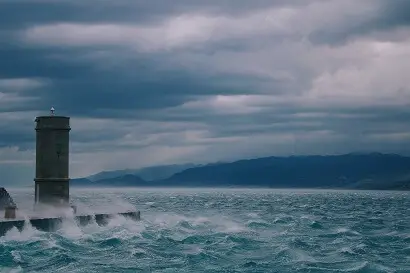There are a number of interesting weather phenomena out there, and among them is one known as the Bora wind. Of course, if you haven’t studied odd weather phenomena, you might be wondering – what exactly is a bora wind, and what does it do?

The Bora wind is a strong, often short-lasting cold wind that is found in the area of the Adriatic Sea during the winter season.
Keep reading, and we’ll delve into everything you need to know about the Bora wind, and how to handle it.
What Are The Characteristics Of The Bora Wind?
The Bora wind is one that appears only in the winter season in the area of the Adriatic Sea or those areas that possessed of similar climate conditions and geographical features. The most common characteristics are the following:
- Extremely cold
- Generally blows from the northeast
- Very strong, with a tendency more toward gusting, rather than steady blowing.
- Often transient: the phenomena rarely lasts longer than 24 hours at a time.
- Very dry in nature.
What Exactly Is A Bora Wind?
In basic technical terms, the Bora wind is known as a katabatic, or falling, wind.
It’s characterized by the movement of large masses of cold air falling from a higher altitude to a lower one.
How Is A Bora Wind Formed?
Bora winds are formed when large amounts of cold air develop and condense – in a manner of speaking – near the peaks of mountains during the winter season.
Cold air tends to sink, just as hot air rises. Once a certain mass of cold air has accumulated, gravity forces it downwards.
The cold air travels from the mountain peaks to the lowest possible altitude – in the case of the Adriatic Sea, it would be sea level – gathering speed as it goes. The result is a dry, freezing wind with unpredictable speeds.
How Fast Do Bora Winds Blow?
The speed at an air mass reaches has to do in part with how much mass is behind it. Bora winds often reach speeds of 60 miles an hour.
Aside from the speed of the main mass, gusts can reach much higher individual velocities. The highest recorded this far has been 248 miles per hour – faster than many hurricane winds.
How Long Do Bora Winds Last?
Many Bora wind incidents last 24 hours or less, However, while they are rarely long, some of them do last longer than a single day.
It’s not uncommon for a Bora wind event to last 4 days, or even as long as a week.
How Cold Do Bora Winds Get?
There’s no set temperature range, as it depends on the temperatures of the peaks, as well as the sea-level air.
The lowest recorded temperature for a Bora wind is roughly 6 degrees Fahrenheit.
Why Are Bora Winds Dry?
The cold air that forms the Bora wind has usually lost most of its moisture by the time it starts to fall.
What Areas Are Affected By The Bora Wind?
The most well-known affected areas are on the edge of the Adriatic Sea. These areas include the Adriatic edge of Italy, Slovenia, and Croatia.
These are not the only areas, only the most commonly reported.
How Do I Know If I’m Going To Encounter A Bora Wind?
If you’re not near the Adriatic Sea or a similar climate during the winter, you’re safe.
If you are in one of these areas during the winter, keep an eye on local weather reports and meteorology stations. They should be able to warn you if a Bora wind looks imminent.
What Should I Do If I Encounter A Bora Wind?
The wisest thing to do is seek shelter and stay inside until the Bora wind passes.
Cold aside, Bora winds can be dangerous. Gusts have been known to flip cars, or worse. Even the average speed can, and frequently does, knock people off their feet.
What Should I Do If Staying Inside Isn’t An Option?
There are several things you should do, especially if you aren’t used to weathering like Bora winds.
- Bundle up: Bora winds are fiercely cold. Even if the air isn’t that cold, the wind speed can make it feel much colder.
- Stay out of the wind as much as possible. Bora winds usually blow from the northeast, so if you can put obstacles between that direction and you, the more the better.
- Stay off the water. Unless you’re very experienced with using a boat in adverse conditions, it can be catastrophically dangerous to go out on the water during a Bora wind.
- Stay out of the water. Water temperature can be deceptive. Even if it seems warm, exposure, particularly with the cold winds of the Bora waiting for you, can be dangerous, even fatal.
- Avoid driving if you’re uncertain of your ability. If you’re only visiting the area, chances are you’ll be using public transportation, but if you aren’t, don’t use your own vehicle unless you’re very sure of your control. The roads might not be icy, but gusting winds can take a car off the road in a heartbeat if you’re not prepared.
- Keep an eye on weather reports. Weather reports are your best resource for avoiding the worst of the weather. They’re also your best resource for staying safe in general, as well as giving you an idea of how long the Bora wind will last, and how it will act.
Final Thoughts
When it comes to weather phenomena, bora winds are one of the colder, and potentially more dangerous ones. With unpredictable gusting winds and the potential for extreme temperature changes, these winds have been described as a winter squall in miniature.
The good news is unless you’re up near the Adriatic Sea in winter, you’re not likely to encounter a Bora wind. If you do, however, the best advice is: Stay in and stay warm, and wait for the Bora wind to blow itself out.
- The Top Restaurants Specializing in Truffle Dishes - August 10, 2023
- Truffle Panna Cotta: A Decadent Dessert Recipe for Truffle Lovers - August 7, 2023
- Truffle Scrambled Eggs: A Luxurious Breakfast Delight - August 7, 2023








